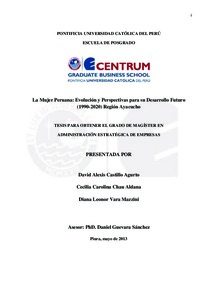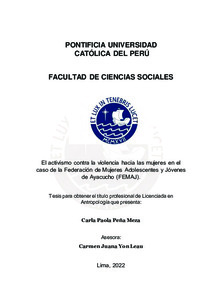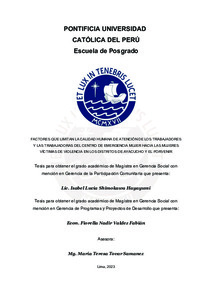| dc.contributor.advisor | Guevara Sánchez, Daniel Eduardo | |
| dc.contributor.author | Castillo Agurto, David Alexis | |
| dc.contributor.author | Chau Aldana, Cecilia Carolina | |
| dc.contributor.author | Vara Mazzini, Diana Leonor | |
| dc.date.accessioned | 2019-05-09T16:08:52Z | |
| dc.date.available | 2019-05-09T16:08:52Z | |
| dc.date.created | 2013-05 | |
| dc.date.issued | 2019-05-09 | |
| dc.identifier.uri | http://hdl.handle.net/20.500.12404/14177 | |
| dc.description.abstract | En el Perú la población femenina y masculina no se encuentran en igualdad de
condiciones y es evidente la discriminación y exclusión de las mujeres. Coincidentemente, las
regiones con menores índices de desarrollo son las que presentan las mayores brechas de género.
La disminución de estas brechas no garantiza el desarrollo de las regiones pero sí contribuye a su
mejora, toda vez que esta mejora depende también de otros factores como la pobreza y la
discriminación por raza y condición socioeconómica, entre otros. Al existir diversidad de
condiciones en las regiones que presenta el Perú se hace preciso el estudio específico en cada
una de estas zonas, con la finalidad de conocer las causas de estas brechas de género y a partir de
ello plantear políticas que contribuyan a su solución.
En tal contexto, la presente investigación se enfoca en la mujer peruana de la región
Ayacucho, sintetizando su situación evolutiva demográfica, educativa, de salud, política y
económica desde el año 1990 al 2010 y recogiendo sus expectativas personales, dentro diferentes
ámbitos, para la siguiente década (2011-2020), así como los obstáculos que encuentran y
pudieran encontrar en el cumplimiento de sus objetivos.
La investigación tiene un propósito descriptivo y ha utilizado un enfoque cualitativo. La
muestra de 27 mujeres ha sido construida utilizando una combinación de las técnicas bola de
nieve y máxima variación considerando las siguientes dimensiones: edad, estado civil, nivel
educativo, nivel económico, y actividad laboral.
Los resultados demuestran una evolución favorable en estas dos últimas décadas en todos
los aspectos estudiados. A pesar de ello, existen aún diferencias importantes con otros
departamentos y la percepción de obstáculos que limitan el desarrollo de la mujer ayacuchana.
Se espera que las recomendaciones efectuadas contribuyan a la mejora de los aspectos negativos
que aún se presentan. | es_ES |
| dc.description.abstract | In Peru, the female and male population is not in equal conditions and the discrimination
and exclusion of women is evident. Coincidentally, regions with lower rates of development are
those with the largest gender gaps. Closing these gaps does not guarantee the development of the
regions but does contribute to its improvement, since this improvement also depends on other
factors such as poverty and discrimination by race and socioeconomic status, among others. As
there are variety of conditions in the regions of Peru, it is necessary the specific study in each of
these areas, in order to determine the causes of these gender gaps and propose policies that
contribute to its solution.
In this context, this research focuses on the Peruvian woman from Ayacucho region,
summarizing the situation evolving demographic, educational, health, political and economic
from 1990 to 2011 and collecting their personal expectations, in different areas, for next decade
(2011-2020) as well as the obstacles encountered and may encounter in meeting their objectives.
The research has a descriptive purpose and has used a qualitative approach. The sample
of 27 women has been built using a combination of snowball techniques and maximum variation
considering the following dimensions: age, marital status, educational level, income, and work
activity.
The results show a positive trend in the last two decades in all aspects studied.
Nevertheless, there are still important differences with other departments and perceived
obstacles limiting women's development in Ayacucho. It is hoped that the recommendations
made will contribute to the improvement of the negatives aspects that still occur. | es_ES |
| dc.language.iso | spa | es_ES |
| dc.publisher | Pontificia Universidad Católica del Perú | es_ES |
| dc.rights | info:eu-repo/semantics/openAccess | es_ES |
| dc.rights.uri | http://creativecommons.org/licenses/by-nc-nd/2.5/pe/ | * |
| dc.subject | Mujeres--Perú--Ayacucho | es_ES |
| dc.subject | Mujeres--Trabajo--Perú--Ayacucho | es_ES |
| dc.subject | Mujeres en los negocios--Perú--Ayacucho | es_ES |
| dc.subject | Mujeres en el desarrollo--Perú--Ayacucho | es_ES |
| dc.subject | Mujeres--Perú--Ayacucho--Condiciones sociales | es_ES |
| dc.title | La mujer peruana: evolución y perspectivas para su desarrollo futuro (1990-2020) región Ayacucho | es_ES |
| dc.type | info:eu-repo/semantics/masterThesis | es_ES |
| thesis.degree.name | Maestro en Administración Estratégica de Empresas | es_ES |
| thesis.degree.level | Maestría | es_ES |
| thesis.degree.grantor | Pontificia Universidad Católica del Perú. CENTRUM | es_ES |
| thesis.degree.discipline | Administración Estratégica de Empresas | es_ES |
| renati.advisor.dni | 09412483 | |
| renati.advisor.orcid | https://orcid.org/0000-0002-6374-8062 | es_ES |
| renati.author.dni | 02881477 | |
| renati.author.dni | 40569338 | |
| renati.author.dni | 41224493 | |
| renati.discipline | 413307 | es_ES |
| renati.level | https://purl.org/pe-repo/renati/level#maestro | es_ES |
| renati.type | https://purl.org/pe-repo/renati/type#tesis | es_ES |
| dc.publisher.country | PE | es_ES |
| dc.subject.ocde | https://purl.org/pe-repo/ocde/ford#5.02.04 | es_ES |









